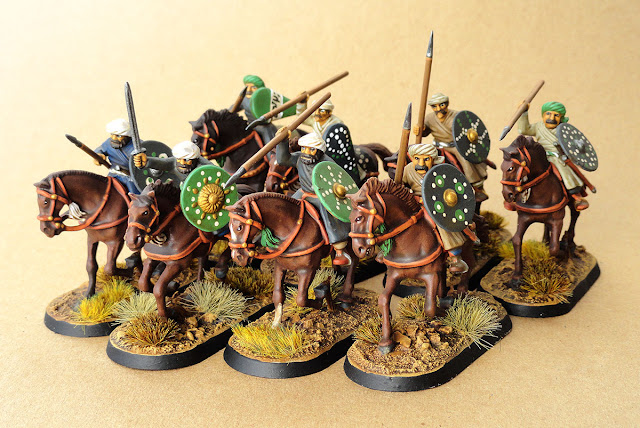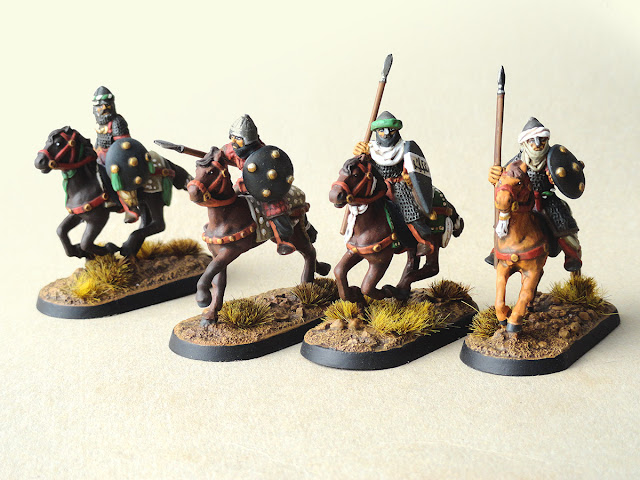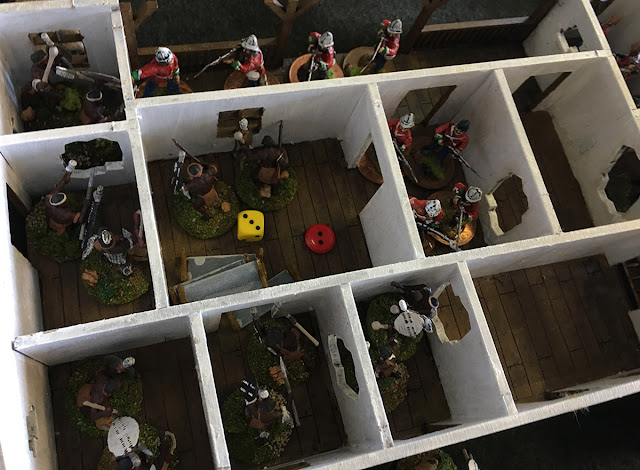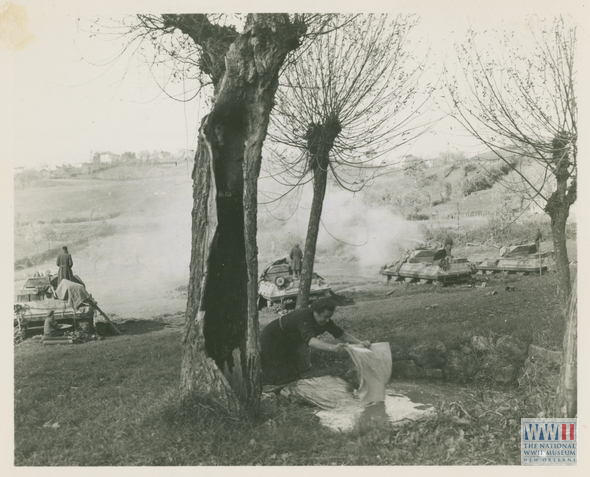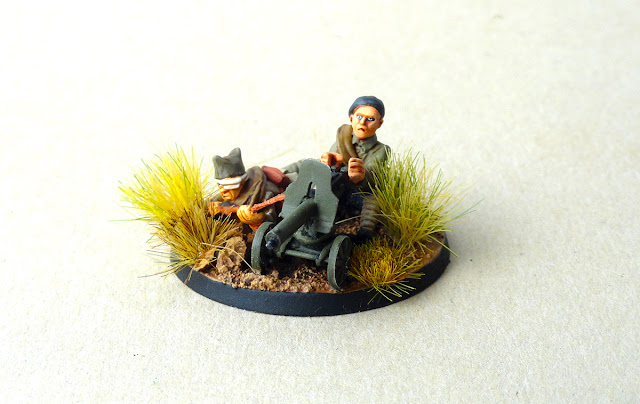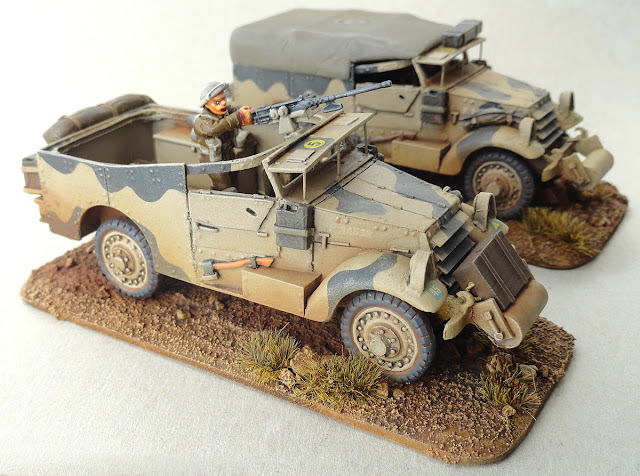Just to wrap up the year, a few more images of some reinforcements for my Saga Crescent and Cross warbands. Some of these can be used in a Moorish force (as mercenaries) or to repurpose my moors as Saracens. Also, to represent the early invasion of the Iberian peninsula, the crossbows in the Moorish list can be replaced by bow-equipped archers.
Friday 22 December 2017
Sunday 3 September 2017
A few more Moors
Another two points of Moors for my Saga Crescent and Cross war band. This brings the core force up to 6 points worth, but used with both the Ben Youssef and Black Guard options, the force can stretch out to 9 points.
I think the force is still sub-optimal. After a few games I have realized I would prefer another point of spear-equipped warriors, and there are not many arguments to take multiple notes of mounted hearthguard.
All the figures were from Gripping Beast - the Jund are more of the metal Saga range, and the Hashid were built from the plastic Light Arab Cavalry box. The plastic figures are fairly plain - I added greenstuff sashes and belts to the plastic figures, to bring them more in line with the fussier metal figures.
This is how the force looks currently:
 |
| Warlord, and heavy cavalry (hearthguard) |
 |
| Light cavalry and spearmen (warriors) |
 |
| 7-point Saga warband |
Wednesday 12 July 2017
Moorish warband for Saga
 Just off the painting table, the first few points of Moors for Saga Crescent and Cross. In keeping with Saga's somewhat tenuous relationship with historical accuracy, I made a deliberate decision to keep the palette very narrow, muted, and, dare I say it, anachronistic. If anyone asks, I will tell them its a fantasy army...
Just off the painting table, the first few points of Moors for Saga Crescent and Cross. In keeping with Saga's somewhat tenuous relationship with historical accuracy, I made a deliberate decision to keep the palette very narrow, muted, and, dare I say it, anachronistic. If anyone asks, I will tell them its a fantasy army...In keeping with my other Saga figures, I used a fairly quick and simple painting style for these. Not sure if they are my best work, but I think they will look okay on the table.
On the face of it, it can work as a 4pt war band (one unit of mounted hearthguard/Jund, two units of warriors/Hashid on foot, and one unit of levy/Mujahid). By using the Ben Youssef figure as a priest/Imam, I can stretch it to 5pts. While I am not sure it will be effective, I can drop the mounted warlord, and instead field Ben Youssef as a Hero of the Crusade, the armored spearmen as an 8-figure unit of Black Guard, together with one unit of mounted hearthguard/Jund, one unit of warriors/Hashid on foot, and one unit of levy/Mujahid) for a total of 7pts!
The bulk of the figures are from Gripping Beast, and were a pleasure to paint. The crossbow-armed fellows are from Artizan, and were, I am afraid, a little less of a pleasure. Artizan are normally a favorite figure manufacturer of mine, but whether from idiosyncratic sculpting or from tired molds, this batch of figures suffered from a serious lack of detail in the undercuts, some nasty splitlines, and some weird blocks of pewter that made no sense and needed to be filed off.
This represents about the halfway point in the development of this force - twelve more cavalry figures (four x Jund and eight x Hashid) are already underway, and after that, a unit of 8 Bedouin scouts and a unit of twelve archers will round out the core options.
Sunday 9 July 2017
Rorkes Drift: 28mm Black Powder Game
Here be a few images from a 28mm Black Powder game of Rorkes Drift, recently hosted by PWG.
Based on the scenario presented in the BP Zulu! campaign supplement, the game was played on a 6 x 8 table, with 48 figures representing the British, and 280 figures representing the izimbutho of the Zulu.
The British command was split between 5 players and the Zulus between 4 players. One club member volunteered to act as umpire.
In order to make the game playable and balanced, the British units were assigned excellent command and control, and layers of special rules that made them unlikely to panic, while the Zulus had poorer command values, but positive special rules that reflected their eagerness to attack, but which "degraded" after their initial assault.
The game played out to a plausible historical result, with the Zulu's defeated despite breaching the perimeter walls and entering the hospital building. In fact, even when assigned a second wave of attackers, the British held steady and made their superior discipline and firepower count.
Many thanks to Lindsay Hall for contributing the bulk of the figures and the terrain, to Simon Hall for contributing additional figures, and to all the players and umpire. Many thanks to Lindsay Hall, Simon Hall and Richard Trevor for the photographs.
Based on the scenario presented in the BP Zulu! campaign supplement, the game was played on a 6 x 8 table, with 48 figures representing the British, and 280 figures representing the izimbutho of the Zulu.
The British command was split between 5 players and the Zulus between 4 players. One club member volunteered to act as umpire.
In order to make the game playable and balanced, the British units were assigned excellent command and control, and layers of special rules that made them unlikely to panic, while the Zulus had poorer command values, but positive special rules that reflected their eagerness to attack, but which "degraded" after their initial assault.
The game played out to a plausible historical result, with the Zulu's defeated despite breaching the perimeter walls and entering the hospital building. In fact, even when assigned a second wave of attackers, the British held steady and made their superior discipline and firepower count.
Many thanks to Lindsay Hall for contributing the bulk of the figures and the terrain, to Simon Hall for contributing additional figures, and to all the players and umpire. Many thanks to Lindsay Hall, Simon Hall and Richard Trevor for the photographs.
Monday 1 May 2017
M10 Tank Destroyer, 1/11 Anti Tank Regiment, Italy 1944
Following on from the Achilles M10 I completed earlier this year, here is the second of the M10 variants I have been working on: a 3-inch equipped tank destroyer as operated by the South African 6th Armoured Division in Italy from the second quarter of 1944.
It depicts a vehicle in the second battery of the 1/11 Anti-Tank Regiment in the camouflage pattern common to many of the vehicles used early in the South African's Italian campaign. Reference photos of these vehicles during the campaign show them to be heavily cluttered (and weathered), and I attempted to create some of that character. I think part of the excessive baggage is due to the South African M10s seldom being used in the anti-tank role - they were rather used as additional field artillery, and were often in static firing positions for extended periods.
Thursday 20 April 2017
28mm Partisans: Heavy Supports
My small partisan force (take a look at the basic infantry and their light supports) is great fun to play using rules like Bolt Action - they are a classic horde force that tends to gain victories by sheer force of numbers. Well-equipped they are not, but they can generate a surprising amount of small-arms firepower. This is great for infantry-only conflicts, but as soon as my opponent fields armored vehicles, even lightly armored troop transports and armored cars, they really find themselves desperately short of heavier weapon options.
With these reinforcements I hope to plug that gap.
First up is a captured Italian Cannone da 75/27 howitzer. It is a bit of a beast for a partisan force - too heavy to be easily towed - and those that were captured in the Balkans were more likely to be destroyed than deployed. But in Bolt Action terms I will use it to represent a light howitzer, the only artillery available to partisan forces. It looks the part.
The kit is the fine offering from Empress Miniatures in their "Italian Conflicts" range, and the crew are from the Empress SCW range, some with headswaps. The Cannone da 75/27 kit is wonderfully detailed, but be warned, it comes without any form of construction diagram, or even a parts list, so a fair bit of sleuthing is required before and during assembly. This is not helped by there being plenty of variations of this artillery piece, and a basic internet search throws up a bewildering array of images that, for the most part, dont appear to share details represented by this kit. That said, I eventually got perfect construction advice from an Empress staff member, and managed to plot the one correct route through a horde of incorrect possibilities...
Next, another recruit from the Empress Miniatures SCW range, with a head swap or two, providing my partisans with a much-needed medium machine-gun option.
In an infantry battle, no-one likes facing an auto canon. And they tend to keep light armored vehicles honest. Light enough to be transported in the carts and mule trains that make up the transport options for my partisans, this is a really force multiplier. This 20mm Breda, or more correctly, Cannone-Mitragliera da 20/65 Modello 35 is from Company B. A tricky little kit to put together, mostly due to the very soft metal of the casting, it none-the-less produces a neat model. It represents the weapon without one of the more elaborate anti-aircraft sights, which I thought was an appropriate arrangement for my part-timers. The crew received headswaps from the Empress and Warlord Games ranges.
Monday 6 March 2017
The White Scout Car (and another overlooked vehicle)
 |
Of all the vehicles used by the South African 6th Armoured Division, the White scout car is probably the most anonymous. Very few photos of this vehicle appear in the various histories of the Division. In two volumes of William Marshall's Camouflage and Markings of the the 6th South African Division there are just three photographs of Whites, one of which is incorrectly captioned as a M5 halftrack, and one of which is included only because it is depicted being towed by a captured SdKfz 7. In fact, Marshall only allowed himself 3 lines of text regarding Whites, noting "a small number of these vehicles were issued to the Division."
In fact, they were the second most numerous armored vehicle in the division (170 in use), only being outnumbered by the Sherman tank variants (255 in use). They outnumbered Universal Carriers 2 to 1, and M5 halftrack variants 4 to 1.
Which is a roundabout way of saying that if you want to build a representative force of the SA 6th Armored Division, best you include a few (or more) White scout cars.
Depicted here along with the Whites, is another vehicle which is often overlooked - the common or garden Dispatch Rider's (Don R) motorbike. The division used a mix of bikes from Ariel, BSA, Matchless, Triumph and Harley Davidson, and together almost 500 motorcycles were issued to the division. After the ubiquitous 3-ton truck (about 2500 in use), they were the second most numerous type of soft-skin vehicle in use.
Ironically, given the broad range of bike manufacturers used, I believe this kit depicts a model not used but the division - the Norton 16H. The rider is a Perry figure, but the Perry bike itself appeared to my eyes to be far too small. Instead, I used the motorcycle from the Foundry "Home Guard" range.
Monday 30 January 2017
T17 Staghound, Natal Mounted Rifles, Italy 1944
At the end of World War 2, the South African 6th Armoured Division listed 15 Staghound T17E armoured cars amongst their equipment. It was not recorded how these were allocated within the Division, and according to Marshall's Camouflage and Markings of the 6th SA Armoured Division, there is only one (poor) photograph known to depict a South African Staghound, and unhelpfully, the AoS number is obscured. The logical allocation would either be to divisional and brigade HQ squadrons, or to the regimental HQ of the dedicated reconnaissance units - the Natal Mounted Rifles. Given that we know the divisional HQ used M8 Greyhounds, the idea that the Staghounds were then rather allocated to frontline regiments is not implausible. The photograph also doesn't provide any clues as to the colour or patterns used - as the vehicle is appears extremely dirty. So this is, again, a speculative representation, and I will be happy to be proved incorrect if anyone can bring to light more complete information on their use in the SA 6th.
The Staghound was a big beast of an armoured car - 14 tonnes worth - with armour as thick as a light tank, and with some innovative drivetrain features. They arrived on the frontline just in time for the Italian campaign, and saw service until the end of the war. In fact, they continued to serve with many commonwealth forces well after World War 2 - the Rhodesians, for example, kept their's going until 1976.
This miniature was built from the Die Waffenkamer resin kit - pretty much out of the box with the exception of the replacement of pintle-mounted .30 Browning with one that came from a Rubicon Models stowage set. One of the crew figures is the kit offering, the other is from Warlord Games. Stowage is either scratch built, or from Die Waffenkamer and Rubicon Models, and decals are from a variety of suppliers: Warlord, Dom's Decals, and Starmer.
I really enjoyed the process and the result of this build. While unashamedly a wargames miniature, it has piqued my interest in building a good scale model of one - who knows, the Staghound might end up being my first 1/35 build in decades...
Subscribe to:
Posts (Atom)






